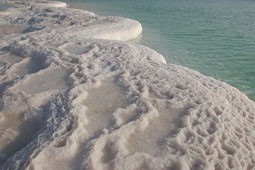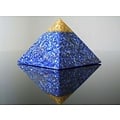What is Magnesium Bathing Salt?
Magnesium is an alkaline metal, the eighth most abundant mineral that can be found in the earth's crust. Because of its solubility in water, magnesium is the third most abundant mineral in sea water, after sodium and chloride. In the human body, magnesium is the eleventh abundant element.
Most magnesium found in the body can be found in the skeleton and the tooth-about 60 to 65 percent of the total. Almost all of the remaining amounts are contained in muscle tissue and cells, while only one percent is absorbed in the blood.

What do you need this Magnesium Bathing Salt for?
The importance of magnesium ions for all life, as well as for general health, is difficult to exaggerate. Magnesium is required to give the "spark of life" to metabolic functions that accomplish energy and transport it (ATP, the fundamental circulation of the body), and the creation of proteins- nuclein acid chemistry of the life-RNA and DNA, in all known living organisms.
In plants, a magnesium ion is found in the center of each chlorophyll molecule, essential for the creation of energy from sunlight. Magnesium is an essential element for both animals and plants, literally involved in hundreds of enzymatic reactions and affecting almost all aspects of life.
Every cell in the human body requires enough magnesium to function, or it will perish. Strong bones and teeth, balanced hormones, a healthy nervous system and cardiovascular system, well-functioning detoxification pathways, and much more, depend on sufficient cellular magnesium.
Soft tissue, which contains the highest concentrations of magnesium in the body, are the brain and heart-two organs that produce a high amount of electroactivity, and which can be particularly vulnerable to magnesium deficiency.
Magnesium works together with calcium to regulate electro pulses in the cell - magnesium concentration in healthy cells is tens of thousands of times greater than calcium, and there are essential reasons for this protection. Cellular calcium channels allow minerals to enter the cell only for as long as necessary to achieve an impulse; it is immediately removed by magnesium once it has fulfilled its task.
This vigilance is necessary to prevent calcium accumulation in the cell, which can cause dangerous hyper-inhibitivity, calcification, cell dysfunction and even cell death. When an abundance of calcium enters the cells, because of insufficient magnesium, muscle contraction lasts too long, and we suffer, for example, from cramps and nerve traits in mild cases.
When magnesium deficiency becomes chronic, we suffer from the symptoms of heart conditions such as angina pectoris, hypertension and arrhythmia, or the cramps and contraction characteristics of asthma, migraine headache or painful menstrual cramps.
Magnesium acts as a natural barrier to the calcium channel and is the cause of relaxation against the contraction of calcium. Thus, magnesium is of great importance for the healthy functioning of our parasympatic nervous system.
It may be hard to believe, but your body is actually designed to function largely in a calm, relaxed, parasympatic state, rather than the palpitations, stress and adrenaline-driven mode of sympathetic nervous system dominance that is almost constant for many of us today, and which consumes large amounts of magnesium.
"Magnesium is very important for many essential bodily functions and the deficiency is integral to so many diseases that more than one researcher has appointed magnesium as a miracle in his ability to solve or improve numerous disorders. The current list of disorders with direct and confirmed connections to chronic and acute magnesium deficiency is long, and includes many diseases, of which conventional medical treatment generally does not focus on magnesium deficiency (see below). Ongoing research promises to reveal further links between magnesium deficiency and other diseases.
bodyRevitaliser Magnesium Bathing Salt effectively consists of Magnesium-Chloride-Molecules (MgCl) and looks like white salt flakes. As will be described later, this form comes from the 250-million year old Zechstein-Sea, about 1500 metres deep underground.
Main Page | Next Page: What are the symptoms of magnesium deficiency?










































